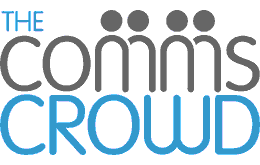The fifth year – growing pains
Time to read: 1 minute
Sam Howard reflects on five years of being freelance…

elli aged 11
A lot can happen in five years. Five years ago my 11 year old little cutey baked cakes and gave freely of his cuddles and enthusiasm. Five years on and my ‘little’ cutey looks down on me in disdain while raiding the fridge and giving freely of his criticism. He loves me really – it’s just a phase right?
And so too has the business side grown up. As a team we have really found our niche now – tech startups, the way we work combined with our business model make us a great fit for the nimble and ambitious startup. None of us have the appetite for long meetings or long emails – we all just want to get stuff done!
Most recently our client work was short-listed for a PRmoment award, for a PR campaign we ran in the public sector. And I confess it feels good to be ranked up there alongside the more established agencies.

It’s gone from being just me to a tight little collective of PR Pros, our AR guy, a designer or two and a trio of copywriters, working together and playing to our strengths. And it’s grown bigger in all the right ways, while holding onto the core freelance premise, which is no premises at all!
Proud to say CommsCrowd HQ is still my former dining room and therefore we still have no need for a receptionist, an IT team, an office manager, an HR team or an accounts department. Just outlook, dropbox, google docs, and some wicked spreadsheets (a personal forte).
In addition to the bulking up of expertise, the other fantastic side of forming the freelance collective is that it offers the opportunity for each of us to develop outside of the world of comms. Whether it’s renovating a 300 year old cottage, bagging munros or learning to surf.
I’ve really got into the talent development element of PR and I’m now an associate lecturer for Westminster University and The London College of Communication. College days are the best days, I get an enormous amount of satisfaction nurturing the next generation of young ones and helping them prepare for the world of work.

elli coming up for 16
And when you feel supported by a brilliant team; when you genuinely warm to your clients and get a kick out of every campaign that delivers; when your pockets are over flowing with psychic income and you’re still learning and still evolving – well then there’s no reason to stop. Here’s to the next five years!
Tips for PR Internship Interviews
Time to read: 2 minutes
Sam Howard interviewed 40 PR undergrads in a day, here’s her top tips for standing out from the crowd.
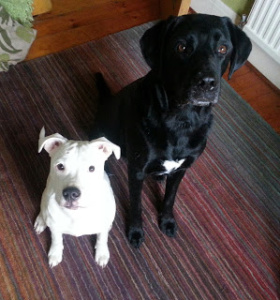
pick me! oh please pick me!
This is what got me, it’s not until you interview 40 potential interns back to back do you realise how important it is to make a mark and stand out, for the right reasons.
Below my top ten tips for delivering a compelling interview:
1) Dress up not down. You’re a student, I know what students look like, show me what you look like as a young professional, help me imagine you in my world. Lads put on a suit, girls tie back the hair, easy on the make-up, everybody make sure the shoes compliment the look and are clean, Oh and take your coat off!
2) Bring in a portfolio and refer to it. Clips, references, college work, certificates etc.
3) Don’t be worried about nerves. We expect you to be nervous and can see through them, just focus on coherent answers that stack up.
4) Be able to answer the question ‘what do we get if we hire you?’ In three words that are true to the core of you. Even if you’re not asked it, have a handle on your personal brand, what it is, what you stand for.
5) If you are studying PR be able to talk about the industry, our issues, our successes, where we are heading, your PR super hero etc.
6) Don’t offer up a single adjective unless you have a story that backs it up. Don’t feel obliged to provide us with skills or qualities that you are unlikely to have at this early stage of your career. If we’re looking for a new CEO we would have advertised for one.
7) Be comfortable with your more humble achievements. The most convincing candidates were those that talked about everyday PR duties, how tricky it was to get coverage when there was no news, to create 10 tweets a day for a fish and chip shop, to get journalists to talk to you – at least that way we know you know what you are letting yourself in for.
8) Don’t be too eager to please, ‘I don’t care where I work who I work for what I do’ isn’t actually that compelling. Moderate your desire to learn with a view of where you’d like to end up.
9) The ability to demonstrate you can own and learn from mistakes is a key character strength not weakness. Be able to be reflective, think about things that have not gone well that were actually down to you not someone else. Why was that, and what did you learn from it?
10) Have a story lined up that lets us see the passion in you the one that lights you up! It doesn’t have to be work related, just something where we can see your natural energy and pride. Good luck, and enjoy the experience!
The fourth year – finding our forever clients
Time to read: 2 minutes
Sam Howard is hitting her prime
Perhaps freelance years are like dog years, for I’m starting feel like I’m in my freelance prime! Four years in, and, as they say on those talent shows, ‘it feels like this is my time’! Oh why’s that then? Well I’ll tell ya.
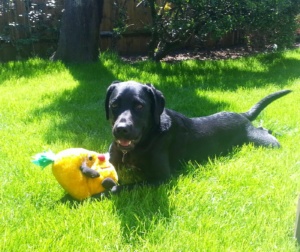
A cuddly pineapple! It’s perfect! It’s what I always wanted!
Tech in general and FinTech in partciular is finally hot!
After some 20 years of apologizing for working in a sector of which nobody has ever heard; countless conversations explaining what I do to those whose eyes glaze over in the time it takes to say ‘enterprise-wide trading systems’ – all of a sudden our sector is hot!
Ya baby!
Not only is our sector hot, my home town for some 30 years, London, is fit to burst with Tech Start-ups and I do love a Start-up – always have! Not for me the 200 page branding guideline bible, the 83 slide PowerPoint on our ‘core’ USPs. Where’s the opportunity to add value to that (other than rip it up)?
I love the pace, the energy, vibrancy that comes with young Tech companies. They are brave, bold and, my lot at least, quite audaciously brilliant. But it’s always struck me, that at the point a young company needs the most care, nurturing and attention to its comms, is just when it can least afford it. Sometimes, that’s not a good fit for a standard agency, where there can be an expectation mismatch, (a big PR budget for a small company is still a small client for a big PR agency). But it’s a great fit for collaborations and small networks of specialist freelancers like us. Freelancers by our very career choices have often rejected the status quo and defined ourselves as fellow disruptors.
Another great thing about working with young Tech companies is the absolute lack of formality. This suits me down to the ground, I want to use my time helping that company do smart comms, not validating how smart I am. Decisions are quick, turnarounds fast, reporting is a spreadsheet in google docs and emails are brief, often littered with typos from both sides. Witness recent email exchange, informing client CEO that we had secured media interest from a noted publication.
ME – OMG We’ve got Forbes!
CEO – F*** yeah!
And of course when you work in a hot sector, in a hot city, with hot clients, you get to talk to media that you have never had the temerity to approach before, but that, it turns out, are really just like us, if you have a decent story to tell. And call me a easily impressed but for a long-toothed B2B fintech PR to be suddenly talking to the nationals, is just really rather cool!
So yeah, in this the fourth year, I find myself, in the right place, with the right business model at the right time – happy freelance birthday to me and the crew, being four rocks!
How to get a bank to put its name to a story
Time to read: 2 minutes
Throughout her career, Sam Howard has always maintained that providing PR for fintech companies isn’t rocket science, however it is a bit tricky. Not only are you, the PR, the only person in the brain-chain without a PhD or three, which can leave you feeling perma-insecure; but also ‘tis hard to tell good stories if there are no good stories to tell.
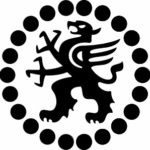
Listening banks are great but talking ones are my favourite
Actually no news isn’t good news – but owing to the nature of the deals, it is not unusual for a small or a start-up fintech company to have just a few client signing announcements a year and those signings usually fall into three categories:
- The no comment: you may not mention the bank in anyway shape or form – great thank you sooo much for that one.
- The vanilla bean: you can prepare something but the details are to be so vanilla and that the quote so bland that it’s barely worth the effort.
- The never never: You get the go ahead on the Friday night, write it on a Saturday, it gets signed off by your team on the Sunday and it’s with the bank for approval first thing Monday morning. And there it will stay, stuck in the corporate food chain awaiting sign off forever more, never to be seen again.
Five tips for getting a bank to sign off a press release
Over the years, working for a fintech start-up, then a fintech multi-national and then a fintech PR agency, these are the tactics I have seen work. It’s a bit of a team effort:
- Incentivize your sales people to negotiate press as part of the contract. Cash bonuses for press releases and double again for a case study, seems to work well enough
- Incentivize your bank by giving them a discount in the contract if they agree to do press, get dates.
- During the sales process and the implementation, stay close to your champion in the bank and work directly with them on the story, using them as the spokesperson, and making sure your story shows your champion as the pioneer they truly are.
- Have the release written and ready to go so that it can be slipped under the nose of your happy, happy client the day everything goes live ahead of schedule and under budget.
- Make the release hardworking and insightful tell the story of the partnership between your company and the bank. Do not dwell on what was wrong in the first place, be realistic no bank is going to sign off a story that goes, ‘well it was just chaos here till you guys showed up’. And keep the quotes real and relevant not an unadulterated and shameless plug for your company. This will make it easier to get sign off, and more credible with the journalists, on whom you ultimate depend to publish it.
What if you hit an absolute wall and can’t get the bank to talk no way no how?
Rather than issuing a no name press release, which somewhat reeks of desperation, consider going down the analyst relations route where your client can freely talk about the project and its successes to the industry analysts under the comfort of NDA.
How the storyteller got her PR stripes
Are you sitting comfortably? Then I’ll tell you how I fell into PR
Once upon a time, many years ago, there was a very bored admin manager who worked for a software development company. She found her job excessively dull, and so would spend much of the day quietly sitting at her computer, writing short stories. For some six months, she (barely) managed to perform her admin duties while working tirelessly on her craft, and soon enough her stories started to get the literary recognition she so desperately craved.
But then one day, the CEO – an entirely overly motivated individual, in her opinion, whom she’d successfully managed to avoid in the main – summoned her to his office. Her heart sunk when she saw upon his desk a sheaf of printouts, not of the latest tedious project timelines, but varying drafts of her stories and poems.
She braced herself to be fired: what cared she? She would live in an attic, make a career move out of being miserable and thin, wear fingerless gloves and die a fine and beautiful death of consumption.
“These are rather good,” he said evenly.
Momentarily thrown off balance but determined to remain on the offensive, she replied, “Well if you can’t give me enough to do, I have to get through the terminable day somehow.”
“My fault entirely,” he concurred with a half-smile.
She glared at him balefully. Was he just passing time waiting for the HR lackey to come in and do his dirty work for him?
Apparently not. “So I was wondering if I might prevail upon you to apply your talents to writing a few stories about the company, our solutions and how we help our customers grow and so forth…”
“Oh, I don’t think so,” she interrupted, immediately seeing a flaw in his plan. “They’d be so boring: who would want to read those?”
“Ah, yes,” he replied with a mere smidge of a vindictive twinkle in his eye. “But it would be your job to make them interesting, tell a good story, engage the reader and what not. Then, maybe, you might talk to a journalist or two, see if you could interest them in writing their own stories about us…”
She looked at him aghast. Why, just the thought of it made her feel queasy. “PR! You want me to do PR??” How very dare he? ”I shan’t do it, I shan’t! You can’t make me!” she wailed.
“Well, no need to agree the brief right now. Why don’t you have the rest of the afternoon off to think about it?”
She grabbed her papers from his desk and stalked with great dignity from his office, not trusting herself to speak.
And so it was that after a sodden gin review of her overdraft facility, our heroine reluctantly conceded that just possibly there were worse things one could do for a living than telling corporate stories.
She’d just do it for a few months before she went and found herself a proper job or, at least had saved enough for a deposit on an attic and a pair of fingerless gloves…
And so, best beloveds, thanks to the thankless intervention of a remarkable CEO, I began my twenty year, hugely enjoyable and vastly rewarding career in PR.
Funny that now, ‘PR is all about telling stories.’ I thought it always was…
The third year – finally finding our feet

sam didn’t get a promotion or even a shoutout but she did get accredited
Time to read: 3 minutes
Sam Howard celebrates three years of being an independent PR person and shares the sometimes painful lessons learned.
The fabulous Victoria Wood once told this joke about how you lavish so much attention on your first child, that you go so far as to score the wall recording for all eternity your firstborn’s height with wonder and awe (since my 13 year old son is already clocking 6ft 3′ we are adding a soupçon of morbid fascination in to the mix now too). Anyhow she went on to remark that by the time you have your third child, you merely note their vertical progress by the rising tide mark of nose smearings on your coat sleeve…
And so it is for freelancing. First year I had a cocktail party and people came from miles around, Second year I at least opened a bottle of champagne and shared it with those that happened to be passing. Third year, Feb 10th completely passed me by. Writing this, with a vodka and tonic in hand is as much as I can muster to commemorate the occasion. Just like a third child – it’s not that I love the freelance life any less, far from it, but just that I’m really busy – new clients, new projects, new sectors, new territories and I got accredited. Even the dog behaves pretty good now.So as is now customary, sharing a few random lessons learned this year:
Cautionary tale – Be careful how much time you allocate to individual pitches.
I have a strong agency background so I like pitching, the smell of the chase, and all that. But it is easy to get carried away, do some sums on the back of an envelope look at the potential gain and then assign a relative cost to winning it. I completely lost it over the summer chasing a big account but where my personal gain was quite insignificant. I blame the heat.
Motivational moment – spread the skills spread the love
As you get busier you may feel inclined to focus on just the high value projects or to really specialize. For example, in line with the industry’s increased appetite for credible content, I have seen a surge in demand for copywriting skills this year, but if I just did that all the time I’d burn out. Much better to have several diverse projects on the go, it keeps the mind agile. And even when you are busy, don’t forget to fill your boots with psychic income – my work with the Taylor Bennet Foundation continues to be the most fulfilling aspect of my freelance career.
Cautionary tale – mates rates have outstayed their welcome
So I’m still working at 2011 mates’ rates for my early retained clients and now I know them so well, asking for an increase on the day rate feels kind of #awkward. But the nicest client in the world is unlikely to suggest you take a pay rise. I’m just going to have to man up – distasteful as it is. Suggest to avoid getting into this situation in the first place any day rate deal you agree comes with the proviso ‘to be reviewed in six months’, ample time to prove your salt and get you on more equitable terms.
Motivational moment – When pickings get plentiful, share the spoils
Share the stress, share the funds, share the love, keep delivering above and beyond. Officially forming the collective was the smartest thing I did this year.
Cautionary tale – Now it’s seven days a week 11-7, and that’s normal
The weekends have become the time to do the behind the scenes stuff, the banking, admin, marketing etc. So to make sure you don’t lose sight of why you turned freelance in the first place, in my case – to spend time with that gargantuan boy of mine – take enforced breaks, ( I’m averaging about eight weeks leave a year). Anywhere that is a Wi-Fi black spot will do nicely.
Motivational moment – I’m really proud of myself
Three years ago I turned my back on the security of an established and respected career, with the attitude of how hard can it be? That was the wrong question. I should have asked, ‘how intense can this be?’ Flipping intense actually. But it turns out, when you learn not to measure your worth by your job title, not to value security above freedom and control, you become infinitely richer, eventually!
Award-winning clients – I’m basking in their reflective glory
Time to read: 1 minute
Tips for entering Tech Awards
Last week, BJSS, a CommsCrowd client, won the TechWorld Award for Best Public Sector project. It’s a genuinely cool project, re-engineering a very big data warehouse, bringing it in house, fully automating it and helping the NHS to save on human resource and money – both scarce commodities in the public sector these days.
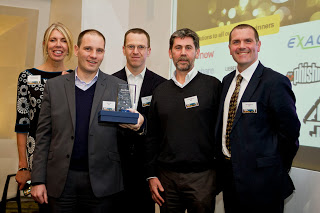 |
| if you had to guess which one of us was not an award-winning software engineer, who would you pick? |
The awards themselves were also impressive, in a transparently objective kind of way, projects were free to enter, award ceremony free to attend and they even gave an award to a company that couldn’t make it – in all my days I’ve never seen that before – fair play.
So I am very pleased for my client, it’s a huge validation of the great work they are doing and I’m pretty pleased for us too. I didn’t write the award-winning software but I did have a hand in writing the award-winning entry.
Here’s some tips for drafting those perfect 1,000 words:
- Get buy in – you can’t do these on your own, work as close as you can with the client ping pong the entry back and forth until it’s perfect.
- Allow enough time – we think it takes about a day and a half on average to draft and edit a standard 1.000 word award entry and that’s assuming you already know the story.
- Start early – it at least three weeks before – get information from source, ie the people that worked on the project.
- Answer the question – every award has a bias so be sure to answer the questions exactly as asked.
- Word count – keep it tight and don’t waffle.
- Before and after stats demonstrating ROI – without these don’t bother to enter.
- Have a heart – think of the poor judges and how many submission they have to read, do make an effort to tell a darn good yarn, keep the narrative sparkly and fluid.
Post Script: other award winning entries include:
- 15/04/2013 Caplin wins Best Web Implemntation at the Sell Side Technology Awards
- 02/12/2013 BJSS wins Best Big Data Project at the Tech Success Awards.
- 15/04/2014 Caplin wins Best Web Development Platform at the Sell Side Technology Awards.
- 14/06/2014 BJSS wins Best Information Technology at the Best Business Awards
- 14/07/2014 BJSS ranked fourth for International Growth in Sunday Times Tech Track 200
- 15/07/2014 Caplin wins Best Trading Technology Vendor at the FX Week Awards
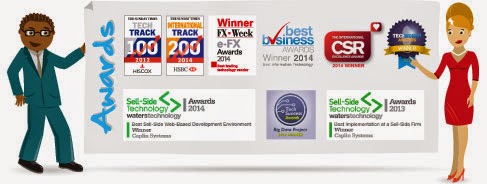 |
| Gonna need a bigger banner |
The free-range freelancer
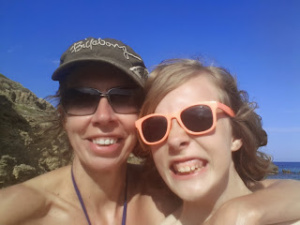
spring 2013 with elli in zante
Time to read: 2 minutes
Never lose sight of why you went freelance. It’s all too easy to constantly be hunting down your next job, but the people (and animals) you love are right here, waiting for you to switch off that laptop.
So I’m comparing tans and my friend and the puny one says, ‘So how come you keep taking all these holidays?’
’Cos my boss said I could.’ I smirk.
My pithy repost was met with a sigh of exasperation.

summer 2013 with mum in devon
Obviously what my mate meant was, ‘So how on earth do you manage both to afford and to maintain client service levels when you are away for much of the summer and you are just a humble freelancer and therefore at everyone’s beck and call 365 days a year?’
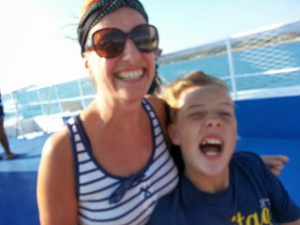
summer 2013 with bestie lynne in puglia
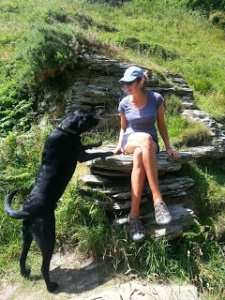
autumn 2013 with moby in cornwall
But one of the main reasons I went freelance was to get closer to a good work/life balance. And I’m guessing that’s why you did too and spending time with the people that matter most is a big part of that. I can’t imagine you turned freelance to earn loads of money – so once the bills are paid, ‘affording’ to take time off is really just a matter of priorities. New bike, or a cycling holiday? New wardrobe, or a tan? It does help that I usually share the work I have got, so it’s easy enough to ask one of the collective to be at the end of the line if a client needs urgent advice while I’m away.
Some freelancers just enslave themselves to their desks due to lack of faith, both in their own worth and the proverbial uncertainty of the future, rather than any real concrete reason. Do your best the rest of the year to look after a good client and a good client will look after you – afterall who needs a bad client
It should be remembered that the proverbial lament of the self-employed, ‘If I don’t work, I don’t get paid.’ Can be flipped on its head to also mean, ‘If I’m ok with not getting paid, I can take time off.’
So this year I did.
Time off in search of half term sunshine on a farm in Greece, country house coddling in Snowdonia, armed with a dongle, we holed up in Devon for weeks, and then went quite AWOL on a vast eating tour of Puglia with the annual 50 miles trek around another bit of the Cornish Coast to get back into all our clothes.
Ok so the blogging, the marketing, the banking, and the admin, the networking, the reading, erm they are in need of tending – but the clients and I are back on track and the house hasn’t been repossessed, there’s plenty of time for filing when it’s cold.
WE ARE LIVE!
Time to read: 1 minute
This post is brief as it is in fact just a shameless plug to say, now it’s official, we exist!

In going live we now have a home for our recently formed small collective of senior comms freelancers, to demonstate their love of B2B technology and our honed range of skill sets, PR, AR, social, content and design.
It’s been nearly two and a half years now since I turned freelance so the collective feels like a natural evolution for me. It’s going to be great for our clients who might be looking for a more robust comms solution than a lone freelancer but who don’t have the appetite nor the budget for the full blown agency commitment, and great for us as we get to collaborate, support and inspire each other while delivering to our strengths. We’re going to be sharing the work the responsibility the money and the love!
It’s taken us forever to get the site together least that’s how it feels to a girl who goes long on ‘genius’ ideas and falls short on patience. But we are live now and despite the fact I’ve been immortalized in Ugg boots, I could not be more proud…
Top ten tips for writing snappy copy
Time to read: 2 minutes
Because B2B commercial copy is for intelligent business consumption, it’s tempting to make it sound grand, but this inevitably makes consumption so much more painful.

Here’s my top tips for edible copy:
- Who are you writing for? Write for one person. Assess their motivation for reading your copy. Will it enlighten, inform, entertain, motivate them to act? Think what’s in it for them. Assess the time they have to read it, their knowledge level.
- Get the knowledge: Sounds obvious, but you need to know/understand at least as much as your reader. If you don’t have the knowledge go and get it. Research it, ask questions, find an expert, get them to draft it if necessary.
- Get it all out: If you find yourself staring at a blank screen then just write anything and everything down to do with what you are trying to say, from this you can create structure, and extract key facts.
- Ask questions which can provide the structure: Ask yourself some basic questions like, Who, Why, When, Where, What and answer them in bullet format. Leave the questions as subheads for now. Arrange the questions into a structure that will form the basis of your logical/persuasive argument.
- Does it serve your purpose as well as theirs? Your copy must add value to the reader but does it also support your company messages, make sure your copy always underlines a key value proposition. If it doesn’t why are you writing it?
- So what? Then read it through, anything missing? Ask yourself, ‘Why do I care?’, ‘So what?’ and, ‘What’s so exciting about that?’ If you’re bored by your own copy, imagine how everyone else feels. (At this stage this might be the longest your copy gets, from here on in we are cutting it back).
- Show not tell: De fluff: Use objective observation and facts to show. Not subjective adjectives and opinion to tell. You are not penning a love letter, but presenting the facts in a compelling fashion. Imagine the building is on fire and you cannot leave the office until you have shouted the story from the window. This exercise will ensure you only use the words you need, to say what has to be said and no more. When it comes to strong copy, a couple of carefully crafted sentences are more effective than a whole paragraph of jumbled thoughts.
- Every time you review it, cut it: Aim to reduce word count every time you review the copy (3-5 times) with decent breaks in between sessions to allow the creative brain to mull over the project, find the right phrase, the most perfect word.
- Don’t force it: Could you sneak your copy into conversation, would it sound natural, or would people think you had gone crazy/swallowed a dictionary/been indoctrinated by brand Y. Be kind to your reader, make your copy easy to read!
- Read final draft out loud: Now print off the copy and read it out loud. This really helps spot the ‘silly’ mistakes that your eyes haven’t seen but your tongue will trip over. It will also help you with punctuation.
You can download these tips in a handy pdf if you like to keep on your desk and front of mind.
